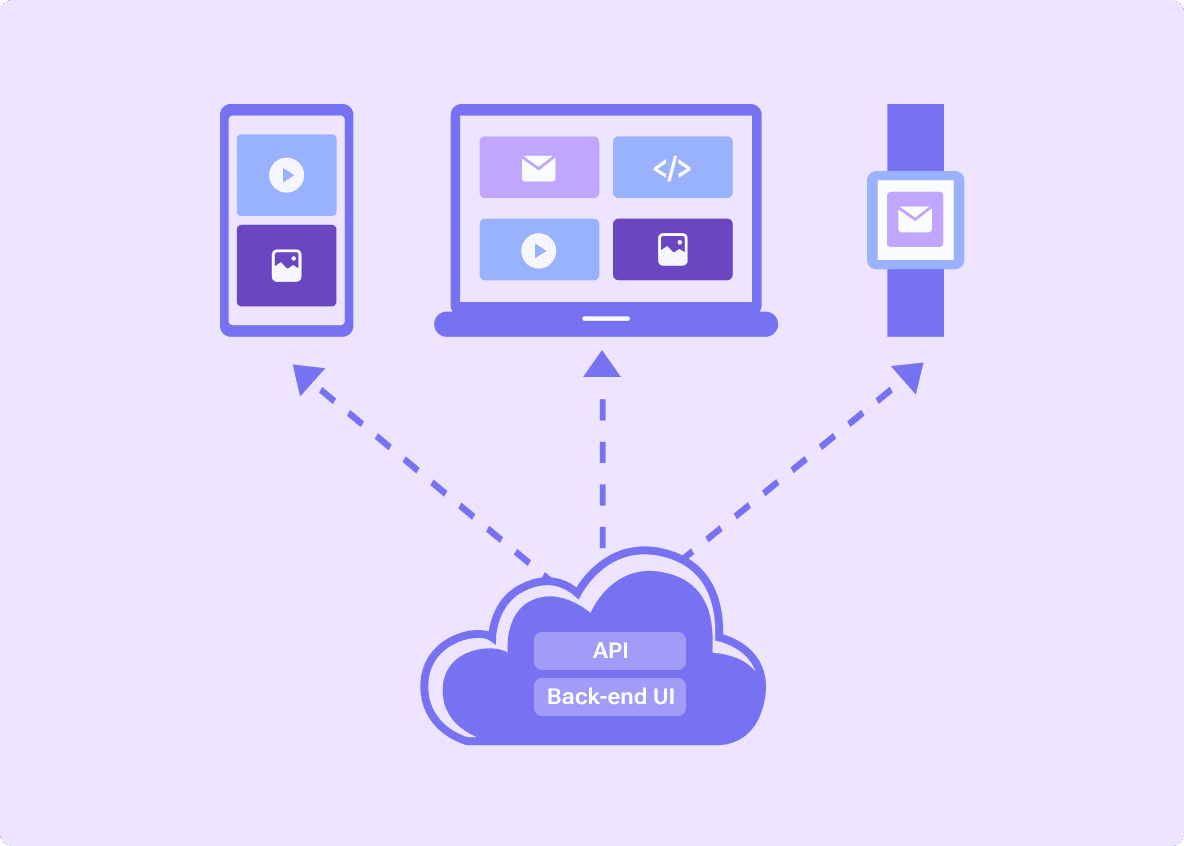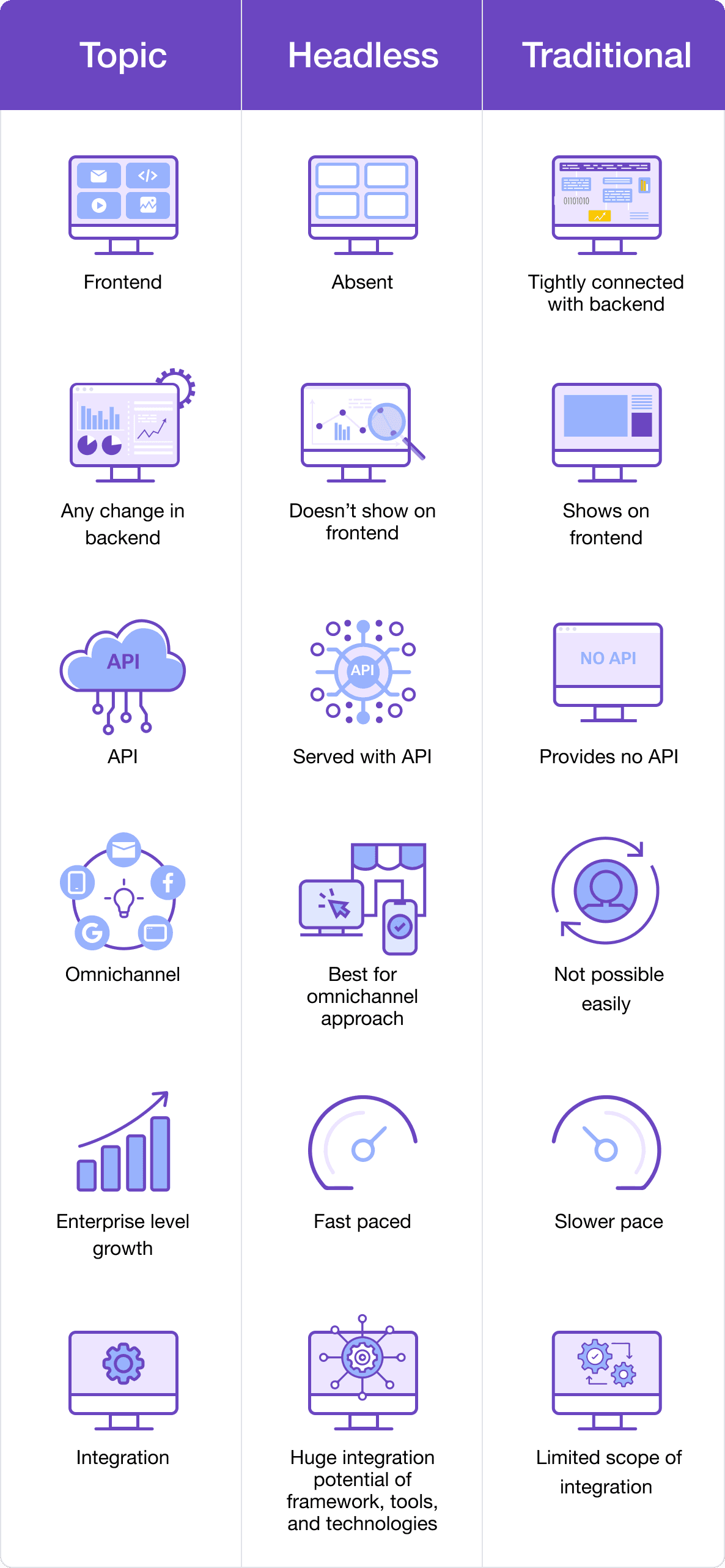Get in touch
hello@stymix.com

You probably know what CMS stands for- content management system. Since the birth of CMS, creating and sharing blogs or online content has evolved significantly. This field has seen several advancements, and in recent years, one such invention that has thrived in this industry is Headless content management system (Headless CMS).
It has caused a stir among developers, opening a new doorway for content creation by rupturing the limitations faced in traditional CMS, such as scalability due to tightly knitted content creation, storage, and presentation layers.
In this article we define what is headless CMS, purpose, and discuss its pros and cons with instances of existing software.

Headless CMS is a content management system that directs content adeptly across numerous platforms. Since headless CMS doesn't have any predetermined method to show content, you will be able to write your content with the freedom to use any front-end tools according to your preference.
Headless CMS provides the content through API (application programming interface) which is a go-between allowing you to collect the data from CMS and make it available on various platforms/frontend.
The availability of APIs such as Graphql, RESTful is one of the main differences between headless CMS and traditional CMS.
The term "headless CMS" simply refers to a content management backend without a front end.
Headless CMS is “headless” because it doesn't have a predetermined way to show you content as its front-end layer (presentation layer) is not present or it is not connected with any specific backend (content repository) or the storage of content. Whereas in traditional CMS the head which is front-end and the body which is backend are strongly connected. That’s why it's not as flexible as headless CMS.
Due to the absence of front end (head) layer headless CMS can seamlessly showcase any content on any platform such as websites, channels, mobile applications, etc with the help of API.
Metaphorically, you can choose any type of head you want with a headless CMS. It ensures a smooth experience and makes it comparatively more likable to the developers.
So basically, here you can create content before designing or developing or even deciding how you want it to look!
With the innovation of more refined devices such as smartphones, laptops, computers people have entered a whole new world of content.
Content consumption has changed dramatically over the last few decades, as have methods of maintaining it.
Without worrying about the frontend layer, you can build anything with greater flexibility and share it however you want.
The pros of headless CMS are as follows:
Headless CMS has a much faster way to edit content compared to their traditional counterpart. For starters, traditional CMS can cost a lot for one massive project as it needs to edit and render the content. On the other hand, headless CMS doesn't have to deal with content editing and rendering on front end, making it overall faster and smoother for you.
In case of headless CMS the code is streamlined for your site. So your site has very fast operations. On top of that, you reduce downtimes. How? Well your dev team can make code changes and your live site doesn't get affected unless when they are making all the changes appear live. So this minimizes your site's downtime showing increased performance and finally increasing user experience.
With Headless CMS, you won't be limited by its capabilities. You can manage your content in one place and with the help of an API you can distribute it across numerous platforms and websites. Headless CMS also gives you an omni-channel experience that offers consistency in your content across several platforms and devices. This functionality is extremely valuable to content creators and developers.
Headless CMS decouples the “body” from its “head” or presentation layer. This separation gives this content management system enhanced security from potential attackers. Since there is no connected path between the presentation layer and stored content, attackers or hackers won't be able to take complete control of the website. This means developers can edit and render their content without the fear of breaches.
Headless CMS is known for its versatility and scalability. You can integrate new tools and technologies easily. Using an API you can fetch the content, share, reuse, and repurpose it on different platforms. This helps diversify the content on numerous websites, and gain new audiences every moment. Due to this inconceivable flexibility headless CMS can assist growth adeptly.
The structure of this management system is designed to cope with new technologies. As new tools can be integrated within the system it'll never go outdated. That's why it is very agile and future-proof and APIs play an essential part in this task. By using headless CMS you can leave all the anxiety at the door. Because you don't need to update all your content to make it compatible with new tech.
Besides, you or your development team can easily create new features for the site and add it effortlessly. This also ensures your site remains updated with modern functionalities.
In case of headless CMS, the frontend of the website is completely absent from where the content is stored, allowing more flexibility whereas front & backend are tightly connected in traditional CMS. But this tight connection any type of changes in the backend visible on the presentation layer. Due to the separation of frontend and backend allows you to create any type of content without worrying about the presentation. APIs serve the content on any channels or websites, whenever it is needed in case of headless CMS. But traditional CMS doesn’t provide any API. Hence no distribution of content and omni-channel activities like its headless CMS solutions.
Again traditional CMS has a monolithic structure. You can't share content to other platforms as you want. Content creators can struggle with this system because of less audience. In headless CMS, APIs can help you earn an audience on various platforms by distributing the content. Thus you can earn more value and see enterprise level growth at a fast pace. You can also integrate any framework, tools, and technologies. But traditional CMS is a fixed system. That's why enterprise-level growth can be comparatively slower than headless CMS solutions. Also it offers only a limited usage of programming languages and tools.
Let's look at a visual representation of the comparison.

There are various headless CMS solutions available that cater to content management and editing. These days, everything is built on multimedia, hence the need for such headless CMS software is growing daily. Because of the additional features and unlimited possibilities, it is also benefiting the commercial sectors.
Here are some of the noteworthy headless content management software you should consider:
Sanity is one of the fastest-growing headless CMSs. Its real-time backend, customization options quick responses are one of a kind, making it more user-friendly.
Strapi is an open-source headless CMS. It's a JavaScript-based platform that allows developers to pick their own tools and frameworks. It has various options to customize your content and have a smooth transition experience. It gets more rigid as you discover other features of it.
Mongolia is one of the first headless CMS that was invented. Even though it’s quite old it still has tons of features that current businesses need. Plus it also offers pre-built integration modules.
Agility CMS has such strong capabilities that it creates high expectations for other CMSs to compete with. This content management software delivers the content with great speed. As it has advanced content management, it can be used to build various complex platforms and supports e-commerce integration.
Contentful is a Germany-based API-driven headless CMS. It has enhanced security that saves your content from the attackers. It even helps small organizations build content by providing content as a service.
Kontent.ai claims to have complete control over your content and enables teams to effectively manage it. Recognized for boosting content ROI, Kontent.ai brings greater success to big projects.
In addition to these, there are more such software that offer the most flexibility, scalability, and security, such as Zesty.io, Cockpit, Contentstack, Directus, etc.
Because of headless content management system, the future of content production and administration appears brighter. Every software has its own set of features and capabilities, therefore it's critical to analyze them based on your individual project needs and team skills. So feel free to research more before jumping into a project with headless CMS or reach out to us as we have tons of experience working with headless CMS.